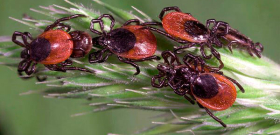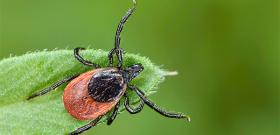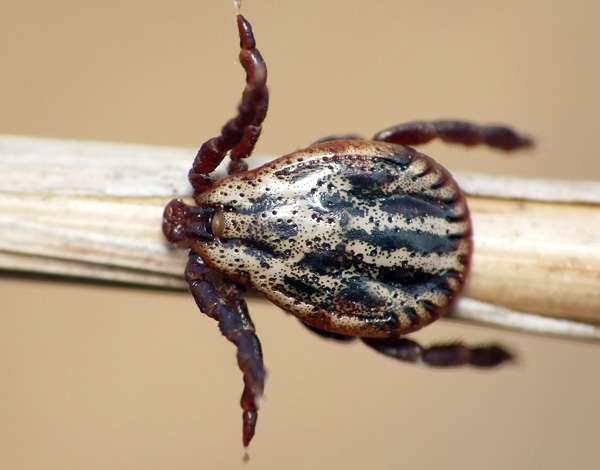
The meadow tick (Dermacentor reticulatus) is a temporary parasite of humans and animals that feeds on their blood. This type of parasitism is characterized by the fact that the bloodsucker settles on the host's body only for food, and lives in the natural environment for the rest of its life.
The species Dermacentor reticulatus belongs to the genus Dermacentor of the family of ixodid parasitiform mites of the arachnid class. The genus Dermacentor has 32 species and has a vast range, including Europe, Asia, North America and part of Africa.
The meadow tick lives in mixed and deciduous forests of western and central Europe, the European part of Russia and Siberia. In Eurasia, its range stretches from northern Portugal and Spain in the west to the territories of Central Asia in the east, representing an elongated strip on the map. This type of tick does not live in the dry Mediterranean climate zone, in Scandinavia and in the northern part of the Baltic region.
In Russia, the range of the meadow tick in the north reaches Smolensk, Moscow and Ryazan, stretches through the Sverdlovsk, Tyumen, Omsk and Novosibirsk regions to Krasnoyarsk in the east, and in the south it captures the Crimean Peninsula, Ciscaucasia and Transcaucasia, as well as western Altai.
The meadow mite is found mainly in open spaces, preferring edges, clearings, meadows, light forests and clearings: focal accumulations of bloodsuckers often form in these places.This arachnid is able to survive flooding - parasites can live under water for up to 20 days.
This species, as well as dog and taiga ticks, occupies a leading position in Russia among other species in terms of the frequency of transmission of diseases dangerous to animals and humans. Most often, meadow ticks are infected with babesiosis (piroplasmosis).
Features of the appearance of a meadow tick
The meadow tick is arranged in a manner typical of all ixodid ticks. Its body consists of a head (gnathosoma) and a torso (idiosoma). It also has four pairs of walking legs, which is a hallmark of arachnids.
All representatives of the genus Dermacentor have a white pattern on the dorsal shield. The bright spotted color of the tick and the presence of eyes are adaptations for life in open sunny areas.
It is interesting
Vision does not play a key role in the orientation of ticks in space and their search for prey. Many species of ixodid do without it completely or have light-sensitive cells that can only recognize light and shadow.
This photo shows a meadow tick:
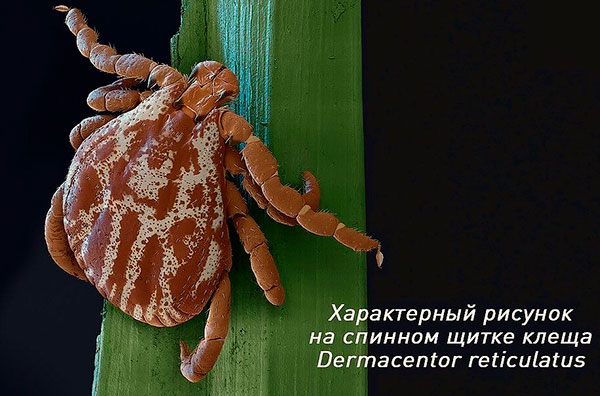
The idiosoma of a hungry tick is flattened, but during the feeding of the bloodsucker it expands and acquires a round or oval shape in a transverse section. This is due to the elasticity of the cuticle that covers the body of the arachnid. The cuticle forms numerous furrows and folds, which straighten out when the parasite is saturated, due to which its body greatly increases in size. The length of a hungry meadow tick is 4-5 mm, and that of a fed one reaches 1 cm.
On the head of the parasite is the oral apparatus. It consists of a proboscis (hypostome), chelicerae and palps. The hypostome has an elongated shape and is covered with hooks and spikes over the entire surface.Chelicerae are designed to cut the skin of the victim. At rest, they are in chitinous cases. The palps perform a sensory function. In ticks of the genus Dermacentor, when folded, they completely cover the proboscis: this design has a bluntly chopped off shape.
Despite the presence of eyes, the parasite receives basic information about the world around it through the organs of touch and smell. The entire body and legs of the arachnid are covered with sensitive sensilla hairs.
The main olfactory organ of ticks is called Haller's organ. It is located on the front pair of legs of the parasite. With its help, the bloodsucker perceives the smells emanating from the victim, captures the carbon dioxide exhaled by her and thermal radiation.
Life cycle of a bloodsucker
The life cycle of a meadow tick consists of four stages: eggs, larvae, nymphs and adults. The development of the tick lasts for one year, adults go into winter diapause.
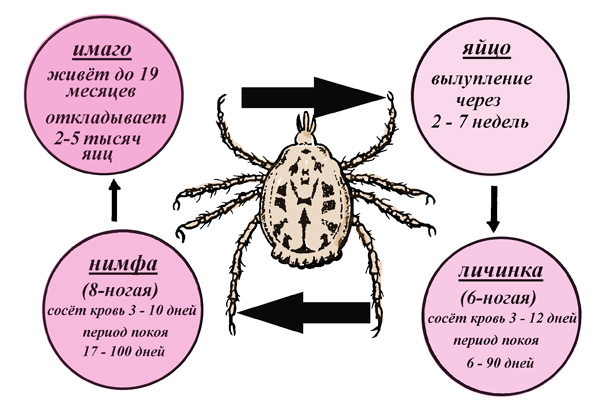
Scheme of the life cycle of a meadow tick.
On a note
Diapauses are inactive periods in the life of arachnids. At this time, they stop hunting and eating, and all their metabolic processes slow down. This condition helps the bloodsucker survive uncomfortable climatic conditions.
Like most ixodid, the meadow tick is a three-host, that is, at each active stage of its development, it hunts a new prey, after which it molts and transforms into the next stage. And at the imago stage, after saturation, the female forms a clutch of eggs.
Normal saturation is possible only in inseminated females. Unfertilized females can remain on the host's body for up to a month, but do not reach a state of satiety. Mating occurs either in hungry individuals in the natural environment, or directly during the feeding of the female.
A feeding unfertilized female secretes volatile pheromones with special glands that begin to work after a few days of feeding. Males catch the smell of these secretions with Haller's organs and, having detached themselves, crawl towards the female. Uninseminated females die malnourished on the body of the host or after leaving it.
A fertilized female lays eggs 1-25 days after the completion of feeding, the larvae hatch on the 44-80th day. The timing of the formation of eggs and the appearance of offspring depend on the ambient temperature. For several days after hatching, the larvae are inactive and do not react to the approach of potential victims.
The larvae and nymphs of the meadow tick feed mainly on small rodents - mice and voles; therefore, the size of the parasite population is closely related to the number of these rodents.
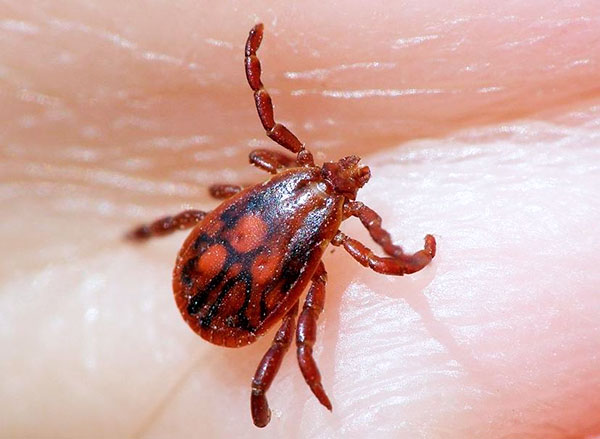
Nymph of the meadow tick.
The main prey of adults is ungulates. The bloodsucker lies in wait for them in meadows and pastures, but it can also attack a person, although he is not the main host of this arachnid.
It is interesting
Ixodids are able to adapt well to environmental conditions. Their attachment to host animals is not rigid, and the choice of the main prey is associated with the habitat and what animals are most often found there. Therefore, the same type of ticks can successfully attack both ungulates, predators, and humans.
An adult individual of a meadow tick is able to live hungry for more than two years. Imagoes of the genus Dermacentor in temperate climates have the longest life expectancy among all ixodids.
timing of parasite activity
Ticks of the genus Dermacentor are very cold hardy.They wake up when the first thawed patches appear. The peak of their activity falls on April-May: hungry and aggressive adults attack large and medium-sized mammals. By the beginning of summer, the activity of parasites comes to naught, and their summer diapause lasts until August.
In autumn, a second, less strong peak of tick activity is observed. Their life activity ends completely when the snow falls.
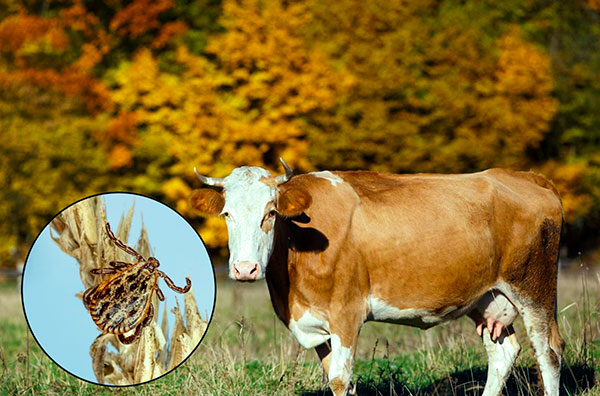
In autumn, the second active phase of meadow mites begins, although it is less pronounced than in spring.
The meadow tick is able to survive the winter only at the adult stage. Hungry adults go into diapause, and females can be both hungry and full, and males can only be hungry. Nymphs and larvae that do not have time to molt die, regardless of whether they are hungry or full.
Females that have fed after midsummer enter reproductive diapause. She does not allow them to lay eggs until spring. This process prevents the death of eggs and hatched larvae during the winter cold.
The mechanism of reproductive diapause of female meadow mites is regulated by the length of daylight hours. This phenomenon is called photoperiodic reaction. The arachnid reacts to the ratio of the duration of night and day, and when daylight hours become shorter than a certain period (this value depends on the region), the diapause mechanism is launched in its body.
Features of lying in wait and attacking the victim
The search for a host is a very important stage in the life of ticks. They use their prey for maximum saturation, increasing their mass by drinking blood a hundred times.
Blood-sucking arachnids passively lie in wait for their prey. To do this, the parasite needs to find a place suitable for the following parameters:
- Optimal temperature;
- Sufficient humidity;
- Availability of prey.
The meadow tick prefers wet grassy fields and thickets of shrubs. The parasite is located on the grass at a height of several centimeters to a meter. Most often, he climbs on dried cereal straws.
The tick settles on a blade of grass with its forelimbs stretched forward. When he feels the approach of a person or animal, he begins to make oscillatory movements with his paws in order to better perceive the smell. In this case, the parasite turns towards the prey, waiting for physical contact in order to crawl onto it.

The meadow tick is ready to attack.
On a note
Contact with the victim is important for the tick, it cannot jump or fall on it.
If the prey does not come close, but its presence nearby (up to 10 meters) continues to be felt, the parasite can descend from its post and crawl to it. The speed of movement of a meadow tick on a horizontal surface is about 40 cm per minute.
Once on the host, the parasite moves for some time through its body in search of a place to attach. The tick prefers to stick where it will be more difficult for the victim to get the bloodsucker, and it is easier for him to cut through the skin and get to the blood vessels.
In most cases, ungulates become the hosts of the meadow tick. It is most often attached to their head or neck. Other favorite attachment sites include the groin, axillae, ears, and the area behind them. A feature of this type of tick is that the parasite, before starting to suck blood, makes several test punctures of the skin.
The arachnid cuts the skin with the help of chelicerae, plunging them deeper and deeper into the wound. At the same time, a hypostome is inserted into the hole, and the palps are bent to the sides.

Mouth apparatus of a tick under a microscope.
From the very beginning of the immersion of the oral apparatus into the skin of the victim, the parasite begins to actively secrete saliva. It has an analgesic effect and suppresses the host's immune response, so the bite goes unnoticed. In addition, after some time, the saliva hardens, forming a strong cement case around the hypostome.
Ticks of the genus Dermacentor are characterized by a short proboscis, most of which remains above the host's skin, while the parasite is firmly attached to the bite site with a case of hardened saliva. Its base is much wider than the incision of the wound due to sagging in the skin tissues of the victim.
An adult male tick needs an hour to saturate, while the female can eat for 9-15 days. The mass of the parasite in this case increases by 50-100 times. The process of nutrition is uneven. During the first 6-36 hours after the start of feeding, the mass of the tick does not change - the arachnid simply replenishes the loss of water. On the 2-7th day of nutrition, its mass increases by 10-20 times. Its greatest growth occurs at the third stage - a day before falling away.
When the female has disappeared, she needs to find a secluded and humid place to form a clutch of eggs, the number of which ranges from 3 to 6 thousand. After that, she dies.
What is dangerous meadow tick
Dermacentor reticulatus bites are dangerous to humans. The saliva of the parasite may contain various pathogenic viruses and bacteria. This type of tick carries pathogens of tick-borne encephalitis, tularemia, Omsk hemorrhagic fever, Q-fever, typhus, babesiosis.
The parasite can become infected through the ingested blood of its victims, sexually and transovarially, when the pathogen is transmitted through the eggs from the female to offspring.
Tick-borne viral encephalitis is the most dangerous disease carried by bloodsuckers. This disease affects the human brain and nervous system, causing severe consequences and can lead to death. In most cases, people who have been ill become disabled. There is no cure for this disease, only supportive care.
Tularemia is caused by bacteria and manifests itself in the form of fever, severe headache, inflammation of the lymph nodes, diarrhea, and sleep disturbances. Treatment is with antibiotics in the hospital. In nature, the sources of this infection are lagomorphs and rodents.
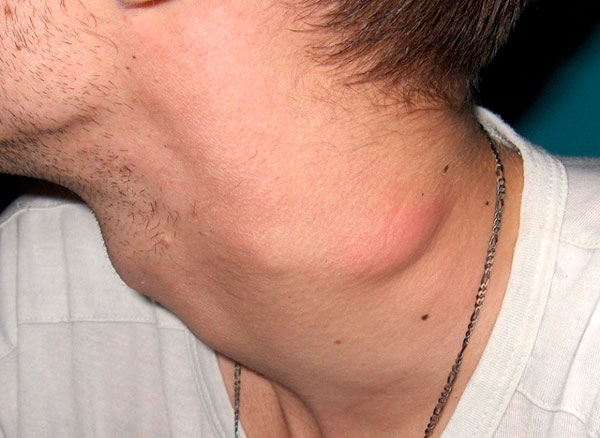
Ticks can become carriers of tularemia. One of the symptoms of the disease is an increase in lymph nodes to the size of a walnut.
Omsk hemorrhagic fever is a viral disease. Its symptoms are a sharp increase in temperature, muscle and headache, nausea and dizziness, the appearance of a hemorrhagic rash, bronchitis. Natural carriers of the virus are the bank vole, muskrat, water rat.
Q-fever (Q-fever) is accompanied by high fever, headache and muscle pain, and a feeling of weakness. Treated with antibiotics in the hospital. Sources of infection are horses, pigs, poultry, small and large cattle, rodents, wild ungulates. In addition to the bite of a tick, a person can contract this fever by contact with an infected animal or by eating its meat. The causative agent of the disease is rickettsia.
Tick-borne typhus is also caused by rickettsiae. Its symptoms are: rash, pain in the head and muscles, high fever. Treated with antibiotics.
Babesiosis, or piroplasmosis, is caused by protozoa - Babesia. This disease usually affects animals.Their temperature rises, the work of the cardiovascular and digestive systems is disrupted. In the acute form of the disease in cattle, the mortality rate is 40%, in sheep and goats - up to 80%.
Babesiosis can affect immunosuppressed people, such as those who are HIV-positive, the elderly, and those who have recently had major surgery or illness. In a healthy person, this disease is asymptomatic.
Other mites of the genus Dermacentor
Representatives of the genus Dermacentor are distributed in Eurasia and America. Most of them (15 species) live in the Palearctic region, which covers Europe, part of Asia north of the Himalayas without the Arabian Peninsula and northern Africa to the border with the Sahara desert. 11 species live in North and Central America, 4 species live in tropical Asia and 2 in Africa, south of the Sahara. Almost all of them are carriers of pathogens of dangerous diseases of animals and humans.
The pasture tick (Dermacentor marginatus) is in many ways similar to the meadow tick, its larvae and nymphs also do not survive the winter. It lives in the south of the European part of Russia, in Western Siberia, Kazakhstan and in the zones of mountain and plain steppes of Central Asia.

The pasture tick is very similar to the meadow tick.
In the steppes of Siberia, Dermacentor nuttali is found, which differs from other representatives of this genus in that not only its adults, but also nymphs can attack a person. Dermacentor silvarum is found in the forest-steppes of the Far East and Eastern Siberia.
The American dog tick (Dermacentor variabilis) lives in the United States and Canada. It settles in deciduous forests, shrub woodlands and meadows.Dermacentor auratus lives in the tropical forests of India and Southeast Asia; adults of this species feed on wild pigs.
The meadow tick is very resistant to adverse natural conditions - frost, flooding - and has a high reproduction rate. Every year more and more new populations of this species appear in Europe, and this carries a great epidemiological danger.
An interesting video about the peak activity of meadow ticks


